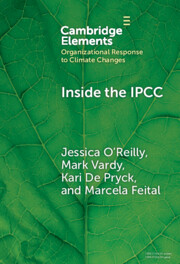851 results

Inside the IPCC
- How Assessment Practices Shape Climate Knowledge
-
- Published online:
- 03 June 2024
- Print publication:
- 20 June 2024
-
- Element
-
- You have access
- Open access
- HTML
- Export citation
Chapter 7 - Mood Disorders and Suicide
-
-
- Book:
- Clinical Textbook of Mood Disorders
- Published online:
- 16 May 2024
- Print publication:
- 23 May 2024, pp 74-81
-
- Chapter
- Export citation
Chapter 14 - Phenomenological Psychopathology of Mood Disorders
-
-
- Book:
- Clinical Textbook of Mood Disorders
- Published online:
- 16 May 2024
- Print publication:
- 23 May 2024, pp 141-150
-
- Chapter
- Export citation
How much or how often? Examining the screening properties of the DSM cross-cutting symptom measure in a youth population-based sample
-
- Journal:
- Psychological Medicine , First View
- Published online by Cambridge University Press:
- 19 April 2024, pp. 1-12
-
- Article
- Export citation
Chapter 2 - Assessment, Formulation and Diagnosis
-
-
- Book:
- Seminars in General Adult Psychiatry
- Published online:
- 04 April 2024
- Print publication:
- 18 April 2024, pp 30-63
-
- Chapter
- Export citation
Chapter 3.1 - Clinical Features of Depressive Disorders
-
-
- Book:
- Seminars in General Adult Psychiatry
- Published online:
- 04 April 2024
- Print publication:
- 18 April 2024, pp 64-88
-
- Chapter
- Export citation
Chapter 58 - Public Health and Pandemic Preparedness
- from Section 5 - Patient Management
-
- Book:
- Clinical and Diagnostic Virology
- Published online:
- 11 April 2024
- Print publication:
- 18 April 2024, pp 292-295
-
- Chapter
- Export citation
Chapter 19 - Comprehensive Geriatric Assessment in Clinical Practice
-
-
- Book:
- Handbook of Old Age Liaison Psychiatry
- Published online:
- 04 April 2024
- Print publication:
- 11 April 2024, pp 283-291
-
- Chapter
- Export citation
Chapter 9 - Dementia and Related Disorders
-
-
- Book:
- Handbook of Old Age Liaison Psychiatry
- Published online:
- 04 April 2024
- Print publication:
- 11 April 2024, pp 110-123
-
- Chapter
- Export citation
The validity of the selection methods for recruitment to UK core psychiatry training: cohort study
-
- Journal:
- BJPsych Bulletin , FirstView
- Published online by Cambridge University Press:
- 27 March 2024, pp. 1-10
-
- Article
-
- You have access
- Open access
- HTML
- Export citation
An epistemology for assessment and development: how do we know what we know?
-
- Journal:
- Industrial and Organizational Psychology , First View
- Published online by Cambridge University Press:
- 18 March 2024, pp. 1-17
-
- Article
-
- You have access
- HTML
- Export citation
HTA community perspectives on the use of patient preference information: lessons learned from a survey with members of HTA bodies
-
- Journal:
- International Journal of Technology Assessment in Health Care / Volume 40 / Issue 1 / 2024
- Published online by Cambridge University Press:
- 05 March 2024, e17
-
- Article
-
- You have access
- Open access
- HTML
- Export citation
Decision making capacity for treatment in psychiatric inpatients: a systematic review and meta-analysis
-
- Journal:
- Psychological Medicine / Volume 54 / Issue 6 / April 2024
- Published online by Cambridge University Press:
- 04 March 2024, pp. 1074-1083
-
- Article
- Export citation
43 - Decision-Making in Civil Matters
- from Part V - Other Legal Decision-Making
-
-
- Book:
- The Cambridge Handbook of Psychology and Legal Decision-Making
- Published online:
- 22 February 2024
- Print publication:
- 29 February 2024, pp 664-674
-
- Chapter
- Export citation
35 - Evaluation Decisions by Psychologists about Causation and Damages in Personal Injury and Employment Discrimination Cases
- from Part V - Other Legal Decision-Making
-
-
- Book:
- The Cambridge Handbook of Psychology and Legal Decision-Making
- Published online:
- 22 February 2024
- Print publication:
- 29 February 2024, pp 540-554
-
- Chapter
- Export citation
Shortening the Alzheimer’s disease assessment scale cognitive subscale
-
- Journal:
- European Psychiatry / Volume 67 / Issue 1 / 2024
- Published online by Cambridge University Press:
- 23 February 2024, e19
-
- Article
-
- You have access
- Open access
- HTML
- Export citation
Evaluating clinical decision support software (CDSS): challenges for robust evidence generation
- Part of
-
- Journal:
- International Journal of Technology Assessment in Health Care / Volume 40 / Issue 1 / 2024
- Published online by Cambridge University Press:
- 08 February 2024, e16
-
- Article
-
- You have access
- Open access
- HTML
- Export citation
Chapter 20 - Personality Disorders
-
-
- Book:
- Mental Health Research and Practice
- Published online:
- 01 February 2024
- Print publication:
- 08 February 2024, pp 355-392
-
- Chapter
- Export citation
Current practices of Portuguese speech-language pathologists with preschool-age children with pragmatic impairment: A cross-sectional survey
-
- Journal:
- Journal of Child Language , First View
- Published online by Cambridge University Press:
- 30 January 2024, pp. 1-18
-
- Article
-
- You have access
- Open access
- HTML
- Export citation
Chapter 1 - The Assessment Process in Consultation-Liaison Psychiatry
-
-
- Book:
- Seminars in Consultation-Liaison Psychiatry
- Published online:
- 04 January 2024
- Print publication:
- 18 January 2024, pp 1-18
-
- Chapter
-
- You have access
- HTML
- Export citation



